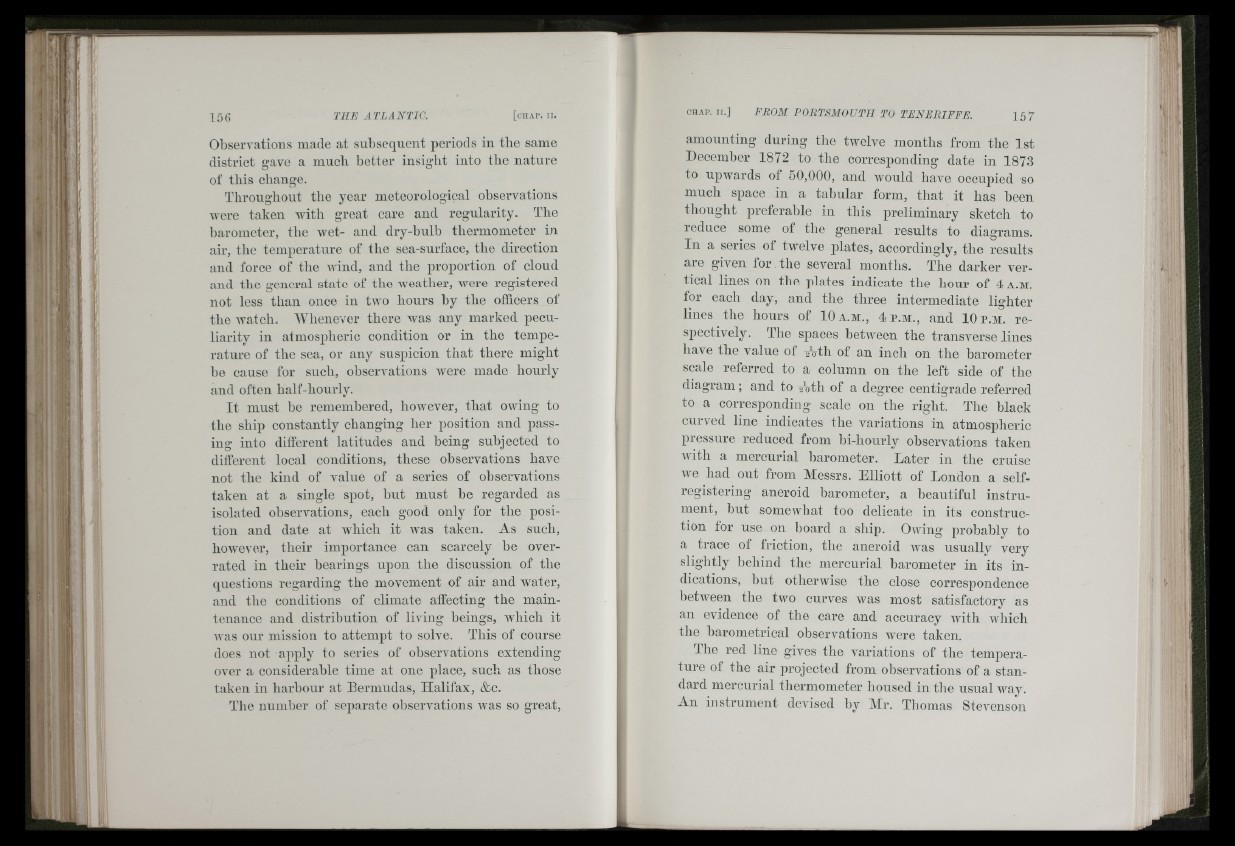
‘tei i M
f
^12
H II
'■i i
fil
i
!A?«i.
1 1«
,i A i
■. i , Í
i A ?
'1
i!
■ijl.
;;
i : JS
‘ ü'
Observations made at subsequent periods in tlie same
district gave a mncli better insight into the nature
of this change.
Tlirougliout the year meteorological observations
Avere taken Avitli great care and regularity. The
barometer, the Avet- and dry-bulb thermometer in
air, the temperature of the sea-surface, the direction
and force of the AA-ind, and the proportion of cloud
and the general state of the Aveather, Avere registered
not less than once in tAvo hours hy the officers of
the Avatch, AVhenever there Avas any marked peculiarity
in atmospheric condition or in the temperature
of the sea, or any suspicion that there might
he cause for such, ohservations Avere made hourly
and often half-hourly.
It must be remembered, hoAvever, that owing to
the ship constantly changing her position and passing
into different latitudes and heing subjected to
different local conditions, these ohservations have
not the kind of value of a series of observations
taken at a single spot, hut must he regarded as
isolated ohservations, each good only for the position
and date at Avhich it Avas taken. As snch,
however, their importance can scarcely he overrated
in their hearings upon the discussion of the
questions regarding the movement of air and water,
and the conditions of climate affecting the maintenance
and distribution of living beings, which it
Avas onr mission to attempt to solve. This of course
does not apply to series of ohservations extending
over a considerable time at one place, such as those
taken in harbour at Bermudas, Halifax, &c.
Tlie number of separate ohservations Avas so great,
amounting during tlie tAvelve months from the 1st
December 1872 to tlie corresponding date in 1873
to upwards of 50,000, and Avould have occupied so
mucli space in a tabular form, that it lias been
thought preferable in tbis preliminary sketch to
reduce some of the general results to diag rams.
In a series of twelve plates, accordingly, the results
are given for the several months. The darker vertical
lines on the plates indicate the hour of 4 a.m.
for each day, and the three intermediate lighter
lines the hours of 10 a.m., 4 p.m., and 10 p.m. respectively.
The spaces between the transverse lines
have the value of ifoth of an inch on the barometer
scale referred to a column on the left side of the
diagram; and to wth of a degree centigrade referred
to a corresponding scale on the right. The black
curved line indicates the variations in atmospheric
pressure reduced from bi-liourly observations taken
AA'ith a mercurial barometer. Hater in the cruise
Ave had out from Messrs. Elliott of London a selfregistering
aneroid barometer, a heautiful instrument,
but somcAvhat too delicate in its construction
for use on board a ship. Owing probably to
a trace of friction, the aneroid Avas usually A'ery
slightly behind the mercurial barometer in its indications,
but otherwise the close correspondence
between the two curves was most satisfactory as
an evidence of the care and accuracy Avith Avliich
the barometrical observations Avere taken.
The red line gives the variations of tbe temperature
of the air projected from observations of a standard
mercurial thermometer boused in the usual way.
An instrument deA'ised by Mr. Thomas Stevenson